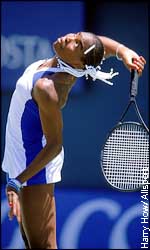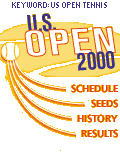| | By Greg Garber
ESPN.com
Venus Williams is 6-foot-1, with extraordinarily long arms. When she serves a tennis ball, the combination of that height and length, plus her explosive skyward lunge at the baseline and the length of her tennis racket gives her an unprecedented advantage.
|  | | Venus Williams has taken her powerful serve all the way to a Wimbledon title. |
In terms of physics, by hitting the ball from that lofty height she has a better angle at the service box and, therefore, more margin for error. The result is the fastest serve in women's tennis history: Two years ago in Zurich, Williams slammed one 127 miles an hour past Mary Pierce on match point.
Her forehand and backhand are similarly blessed with speed and power, which is why it is so distressing to Williams' peers that she spent two August weeks at home in Palm Beach Gardens, Fla., working on her dropshot. It was on display at the Pilot Pen tournament in New Haven, Conn., the warmup for this year's U.S. Open.
Like Tiger Woods, who is redefining excellence in another arena, Venus Williams is still learning to master her domain. Just as Woods has become the longest and one of the most accurate off the tee and still managed to exhibit an uncanny putting touch around the greens, Williams now has the ability to hit the biggest serves as well as the most subtle of dropshots. This is what happens when you are better than everyone else; it is almost too easy, so the motivation to improve must come from within.
In a second-round match at the Connecticut Tennis Center at Yale University, Williams met Russian Elena Likhovtseva, a formidable player ranked No. 23 in the world. Williams, by her standards, played poorly. Likhovtseva, who has a wonderful return of serve and an elegant backhand, played well. Williams won 6-3, 7-5.
"I don't think I was as serious as I should have been, as far as just closing out points and as far as doing the right thing at the right times," Williams said afterward. "I don't think I was as intense as I should have been.
"I shouldn't have let up on her the way I did. I think it's a bad thing to say I was bored, but I think maybe I as trying too many dropshots and that caught up with me."
Likhovtseva had five set points in the squirrely, 10-deuce 10th game of the second set, but she couldn't convert one. In one game, Williams opened with a 107 mph ace down the middle and closed with an 80 mph changeup for another ace, sliced sweetly to the outside. That's a wider range than, say, Boston Red Sox pitcher Pedro Martinez. So how do you prepare?
"It's tough," Likhovtseva said. "You know, you guess. That's why she serves aces."
According to the U.S. Open seedings, Williams is the third-best player in the tournament, behind No. 1 Martina Hingis and No. 2 Lindsay Davenport. This is utter nonsense. The fact is, neither woman has beaten Williams this year. She dispatched both of them on the way to her first Grand Slam title in July at Wimbledon. Later that same month, she crushed Davenport in the final at Stanford.
Williams missed the first four months of the season with tendinitis in both wrists and there were reports, fueled by her father Richard, that she might retire. The sabbatical seems to have done wonders for her game.
After a predictably slow start, Williams is the hottest player in tennis. Going into Pilot Pen she had won three straight tournaments and crafted a 15-match winning streak. At age 20 she is, almost unbelievably, a work in progress.
It wasn't long ago -- nearly a year, to be precise -- that Williams' sister Serena, now a month shy of her 19th birthday, was annointed as the next big thing. Richard Williams said so himself after Serena broke through at the U.S. Open with her first Grand Slam title and had a combined 6-1 record against Hingis and Davenport.
Nearly forgotten was Venus, who had reached the U.S. Open final in 1997 at the age of 17 years and three months, eight months younger than Serena was last year at Flushing. Venus lost that championship match to a 16-year-old Swiss player, Hingis. When Serena beat an older Hingis in the 1999 final, it seemed logical that she was destined to be a greater player.
Now, of course, all bets are off.
Hingis won three Grand Slam titles in 1997, all before she turned 17, but there is a good chance she will never enjoy that kind of domination again. She is a marvelous player with an enviably complete game, but at 5-7, 130 pounds she cannot match serves and baseline strokes with the Williams sisters, Davenport or French Open champion Mary Pierce, who are all 5-10, 150 pounds or better.
Another daunting thought: Venus Williams is faster than all of those heavy hitters.
Williams, it must be remembered, did not come up on the junior circuit. Richard Williams defied convention and essentially home-schooled his daughters before allowing them to play modest professional schedules. Hingis, for example, is three months younger than Williams but has played nearly 200 more professional matches. What's going to happen when she actually begins to understand the game?
After defeating Serena in the Wimbledon semifinals, Venus talked about how far she had come since the 1997 U.S. Open loss to Hingis.
"That was my third Grand Slam," she said. "I wasn't even full-time on the Tour. I didn't understand any strategy as far as let's say you're down break-point, maybe you should get your first serve in. Things like that never came to my mind.
"It was totally different circumstances, yeah. It's extremely different from now."
Greg Garber is a senior writer at ESPN.com | |
ALSO SEE
Williams sisters could meet in U.S. Open final
U.S. Open women's draw
|


